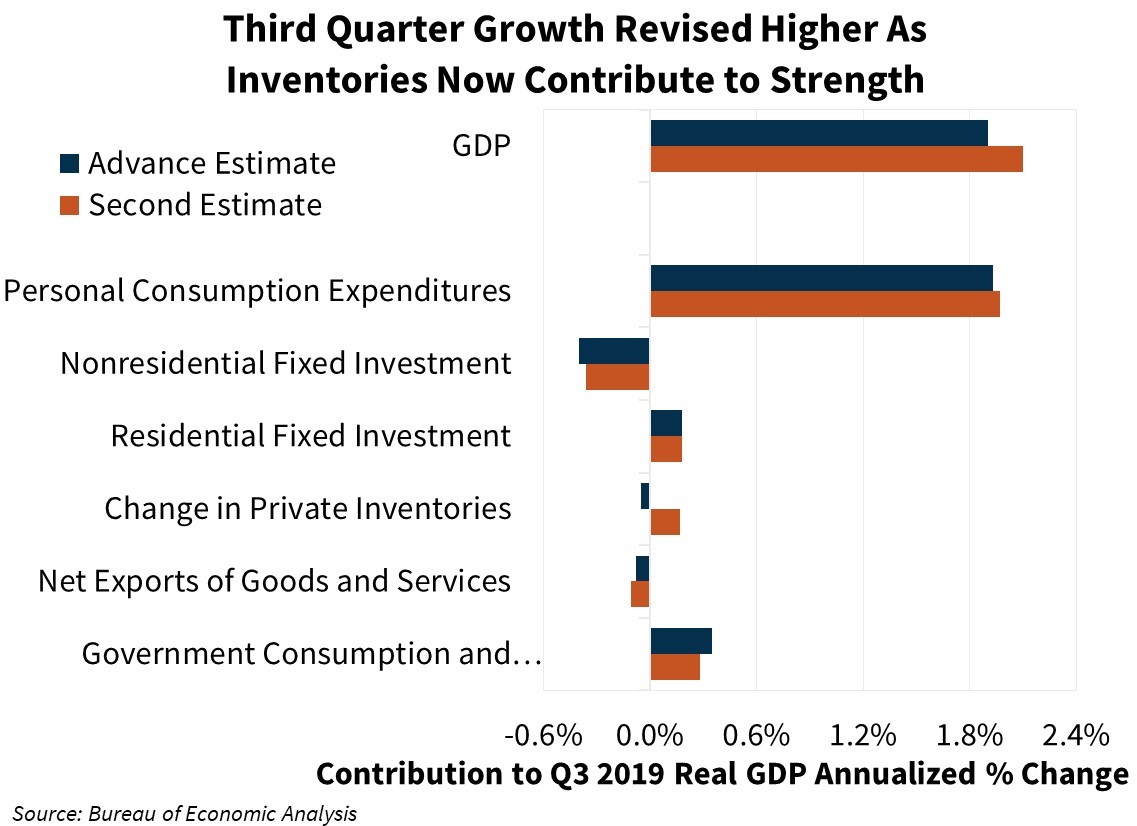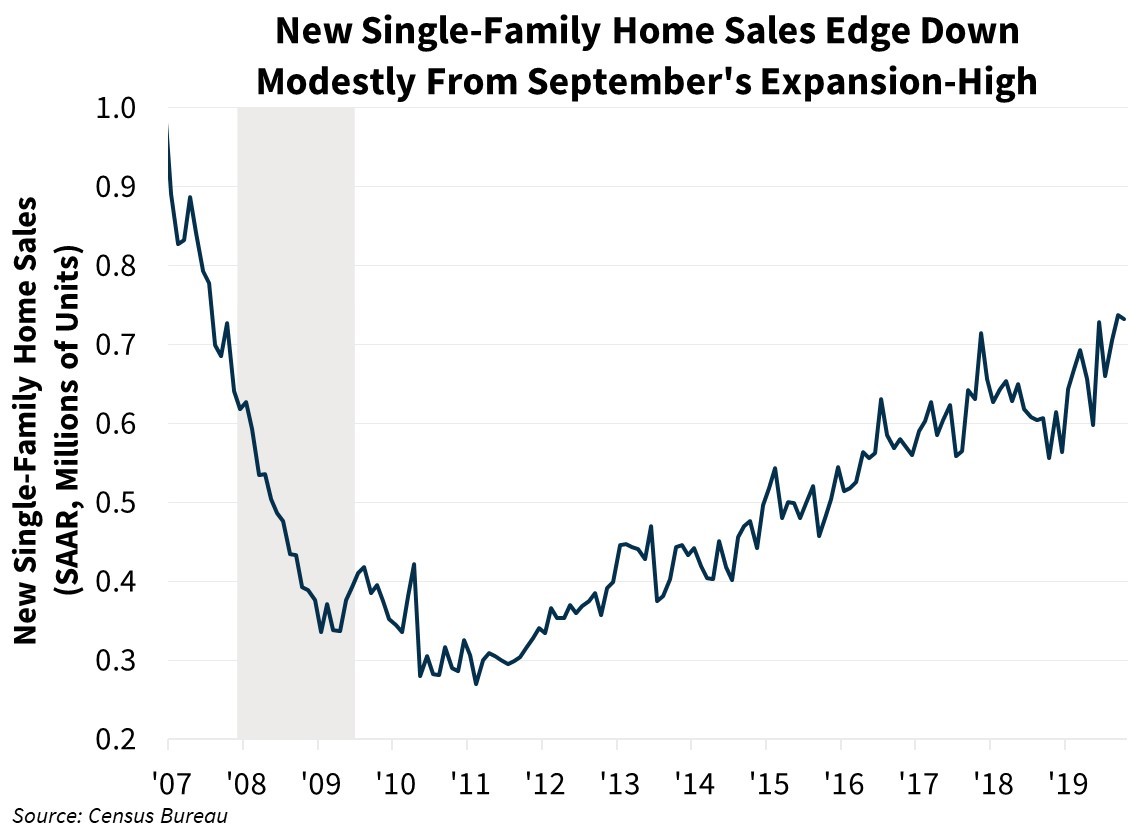Third Quarter Real GDP Growth Revised Higher
Key Takeaways:
- The second estimate of real gross domestic product (GDP) growth in the third quarter showed headline growth was revised two-tenths higher to 2.1 percent annualized. Details showed a small upward revision to business fixed investment countered by downward revisions to net exports and government spending. The largest adjustment was to business inventories, which went from dragging slightly on growth to adding two-tenths to GDP. Growth of real personal consumption expenditures (PCE) remained the largest contributor to GDP growth.
- Corporate profits edged up slightly in the third quarter but decelerated sharply from the pace seen in the second quarter, which was the fastest in three years. After-tax profits also slowed from the second quarter but have recovered from the sharp drop seen at the beginning of this year.
- Real personal income fell in October, posting the largest monthly decline since March 2015. Real PCE rose over October but did so at the slowest pace since February.
- Annual growth in the PCE price deflator, the Fed’s preferred inflation gauge, held steady at 1.3 percent in October, while core inflation (excluding food and energy prices) slowed to 1.6 percent.
- New home sales, which are recorded at contract signing, fell modestly in October but remained near the expansion-high recorded (after revisions) in September. Inventories, however, remain constrained, with new homes available for sale declining on a year-over-year basis for the second consecutive month and posting the largest drop in nearly seven years. Additionally, the months’ supply remained below 6.0 months (considered a balanced level) for the third straight month.
- Pending home sales, which measure contract signings of existing homes, fell for the first time in four months in October. The National Association of REALTORS® press release attributed the decline to a lack of inventories and a small rise in mortgage rates from September.
Forecast Impact
The significant upward revision to business inventories in the third quarter reinforces our forecast of decelerating growth in the fourth quarter as a drawdown in inventories materializes. Slowing growth in PCE will also likely drive decelerating growth in Q4; real consumer spending edged up only modestly in October and the decline in real personal income points to a sharp slowdown in PCE this quarter. Inflation should remain a key concern for the Federal Reserve heading into its December policy meeting as inflation rose only 1.3 percent, well below the Fed’s 2.0-percent target and tying the slowest pace of growth in three years. While new home sales fell slightly in October, the upward revisions to the prior months will likely mean upward revisions to our home sales forecast for the year. However, the decline in pending home sales and consistently constrained inventories of both new and existing homes reinforces our view of slowing sales heading into 2020.


Details on Key Takeaways and Other Releases:
- Gross domestic product, adjusted for inflation, rose 2.1 percent in Q3 2019, according to the second estimate from the Bureau of Economic Analysis. Business fixed investment was revised upward from a decline of 3.0 percent to a decline of 2.7 percent. Growth of government consumption was revised downward from 2.0 percent to 1.6 percent. The largest adjustment was to business inventories, which went from dragging slightly on growth to adding two-tenths to GDP as the real change in inventories was revised from 69 to 80. Corporate profits and corporate profits after tax rose 0.9 percent and 5.2 percent annualized in the third quarter, respectively.
- Personal income, adjusted for inflation, fell 0.2 percent in October, according to the Bureau of Economic Analysis. Real PCE grew by just 0.1 percent. The PCE deflator rose 0.2 percent and the core PCE price index increased by 0.1 percent.
- New single-family home sales fell 0.7 percent in October to a seasonally adjusted annualized rate of 733,000, according to the Census Bureau. Sales in the prior three months were revised higher by 32,000 units on net, which put year-to-date sales 9.3 percent higher than sales during the same period in 2018. The for-sale inventory declined 2.4 percent from a year ago, the biggest decline in nearly seven years. The months’ supply edged up from 5.2 to 5.3 months. The median price, which is not adjusted for the mix of sales, fell 3.5 percent from a year ago.
- The National Association of REALTORS® Pending Home Sales Index, which typically leads closings by one to two months, decreased 1.7 percent in October. Pending sales fell in every region but the Northeast. From a year ago, pending sales rose 4.4 percent.
- The FHFA Purchase-Only House Price Index, reported on a seasonally adjusted basis, increased 0.6 percent in September. From a year ago, the index rose 5.1 percent, accelerating from the 4.7 percent reported in August. The S&P CoreLogic Case-Shiller National Home Price Index (not seasonally adjusted) edged up 0.1 percent in September and accelerated by a tenth to 3.2 percent from a year ago.
- Durable goods orders rose a modest 0.6 percent in October, according to the Census Bureau. A sharp increase in defense aircraft orders to the highest level in over a year counteracted softness elsewhere. Core orders (nondefense capital goods excluding aircraft) rose 1.2 percent, the largest gain since the beginning of this year, and core shipments rose 0.8 percent, the first increase in five months.
Rebecca Meeker
Economic and Strategic Research Group
November 27, 2019
Opinions, analyses, estimates, forecasts and other views of Fannie Mae's Economic and Strategic Research (ESR) Group included in these materials should not be construed as indicating Fannie Mae's business prospects or expected results, are based on a number of assumptions, and are subject to change without notice. How this information affects Fannie Mae will depend on many factors. Although the ESR group bases its opinions, analyses, estimates, forecasts and other views on information it considers reliable, it does not guarantee that the information provided in these materials is accurate, current or suitable for any particular purpose. Changes in the assumptions or the information underlying these views could produce materially different results. The analyses, opinions, estimates, forecasts and other views published by the ESR group represent the views of that group as of the date indicated and do not necessarily represent the views of Fannie Mae or its management.
